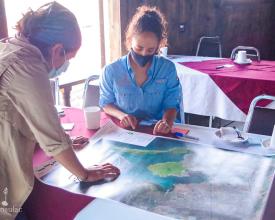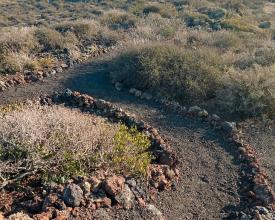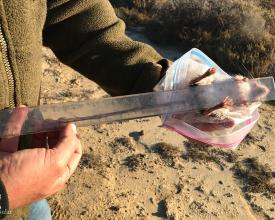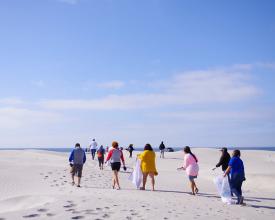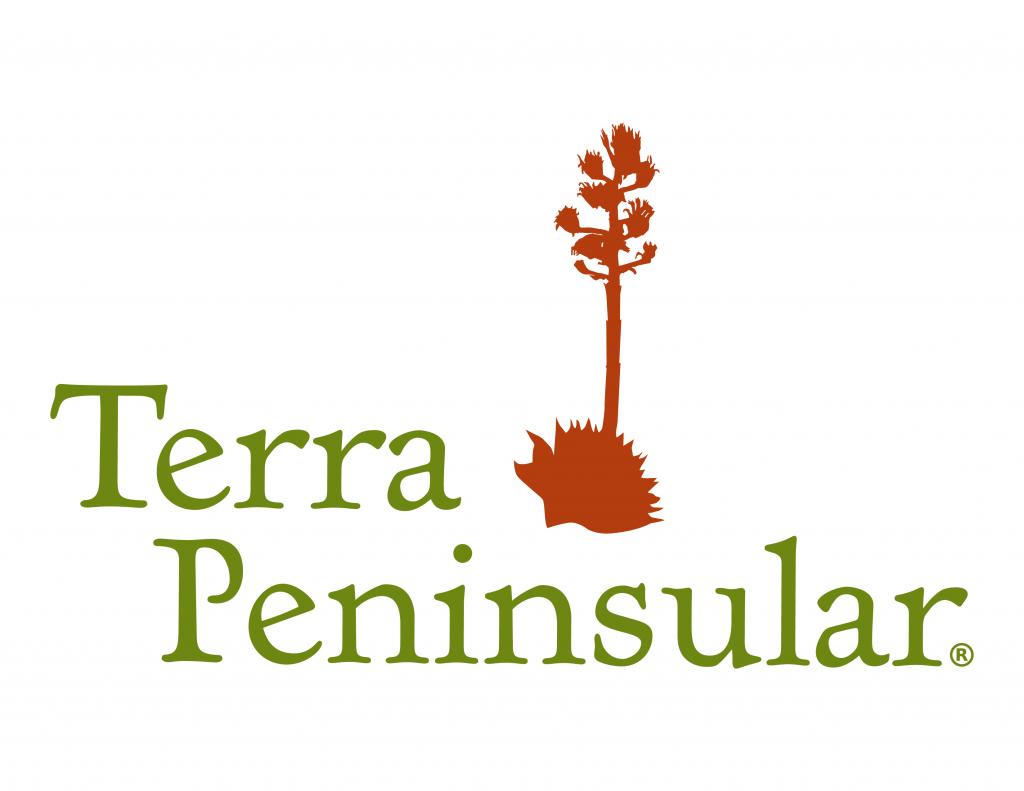La réserve naturelle de San Quintín pour tous

La baie de San Quintin est l'une des baies côtières les mieux préservées de toute la côte pacifique de l'Amérique. Depuis 2001, l'association civile Terra Peninsular concentre ses efforts sur la garantie du maintien de la valeur écologique de cette baie dans l'intérêt des communautés actuelles et futures.
Notre objectif est de garantir la protection à long terme des zones naturelles grâce à une stratégie qui comprend la protection juridique, la gestion adaptative de l'habitat et un travail continu avec les communautés :
- Nous identifions les zones naturelles de grande importance et appliquons les modèles de gestion les plus appropriés pour assurer leur protection à long terme.
- Nous menons des actions de conservation dans les zones protégées : suivi biologique, programmes de surveillance, services aux visiteurs, entretien des infrastructures et restauration.
- Nous encourageons la participation active de la société par des activités de sensibilisation, des événements, des festivals et l'éducation à l'environnement.
Contexte
Défis à relever
Notre stratégie de sensibilisation et de participation sociale souligne l'importance de la dimension humaine pour assurer le succès à long terme de la conservation de la nature. Cet objectif est atteint grâce à la sensibilisation, au dialogue sur les connaissances, à la participation de la communauté et à l'autogestion. L'éducation, la création de contenus pertinents et utiles et l'application d'outils méthodologiques permettant de connaître et de comprendre les opinions et les perceptions des communautés qui interagissent avec les espaces naturels constituent des éléments fondamentaux de la mise en œuvre de cette stratégie.
Nous avons créé le Festival des oiseaux de la SQ comme une opportunité de connecter les communautés avec leur environnement naturel, une approche du travail de conservation réalisé dans la baie, et un espace pour promouvoir l'observation des oiseaux comme une activité à faible impact environnemental, qui éveille la curiosité et contribue à la connaissance des communautés.
Emplacement
Traiter
Résumé du processus
Les projets de conservation de Terra Peninsular travailleront toujours dans une pratique transversale entre les programmes et jamais indépendamment d'eux, en recherchant une séquence logique qui relie un programme à un autre, maximisant ainsi les succès de l'organisation en matière de conservation. Quelques exemples de la manière dont les trois actions ont été menées avec succès : nous avons redécouvert une espèce que l'on croyait éteinte depuis plus de 30 ans, le rat kangourou de San Quintin(Dipodomys gravipes). Nous y sommes parvenus en collaboration avec le musée d'histoire naturelle de SD. Un autre exemple est la campagne "La playa es de todos", qui vise à protéger le pluvier des neiges pendant sa période de reproduction. À ce jour, elle a permis de préserver quatre saisons de reproduction du pluvier des neiges. Pour ce faire, des alliés clés se sont joints à la campagne, notamment Pacifica à Ensenada, pour représenter l'industrie immobilière. Dans le cadre de la campagne, des événements d'éducation à l'environnement, des nettoyages de plages et la création de matériel de sensibilisation ont été mis en œuvre avec la participation de bénévoles et d'étudiants. Nous avons apprécié les résultats de la mise en œuvre des actions de gestion et de sensibilisation, ce qui nous permet de passer à l'étape suivante, à savoir l'application de l'action de protection juridique pour assurer la conservation du pluvier argenté dans cette zone.
Blocs de construction
Protection et gestion des habitats
Cette solution combine plusieurs actions pour rendre plus efficace la mise en œuvre des efforts de conservation d'un site. La protection et la gestion des habitats sont encadrées par l'analyse territoriale des sites prioritaires et l'application d'instruments de conservation adaptés à la conservation et à la durabilité.
Grâce à différents instruments, la protection des sites crée une base juridique pour la gestion adaptative des zones les plus critiques pour leur valeur biologique. Certains de ces instruments peuvent être des accords de conservation, l'achat de terres, des concessions de zones côtières fédérales pour une protection à part entière, ou une collaboration pour créer des sites Ramsar, des sites du WHSRN, des zones naturelles protégées dans différentes catégories, des accords de destination, entre autres. La collaboration est un principe directeur de cette stratégie, c'est pourquoi nous entretenons des liens très étroits avec les autorités de l'État de Basse-Californie, avec les autorités municipales et locales des ejidos et des communautés, ainsi qu'avec les secteurs environnementaux à tous les niveaux, tels que SEMARNAT, CONANP, PROFEPA et la direction générale de la zone fédérale maritime-terrestre, pour ne citer qu'eux. Ces collaborations ont permis de protéger des milliers d'hectares en Basse-Californie, principalement dans des zones essentielles telles que San Quintín.
Facteurs favorables
Nous devons protéger les habitats naturels uniques présents dans les habitats de la péninsule de Basse-Californie et préserver la beauté naturelle en garantissant l'intégrité du paysage et de l'écologie. Tous les efforts de conservation et de protection de la biodiversité reposent sur une base scientifique solide, ce qui garantit la crédibilité de notre travail et nous assure que nous nous occupons des habitats prioritaires fondamentaux. Nous pensons qu'il convient d'utiliser au mieux les ressources disponibles en travaillant en étroite collaboration avec d'autres organisations qui partagent des valeurs et des intérêts communs.
Leçon apprise
Ce qui nous rend très fiers, c'est que l'équipe qui est restée à l'avant-garde a accompli tant de réalisations, et que nous sommes toujours là. Le fait que nous soyons reconnus au niveau national et international dans le domaine de la conservation des terres. Le travail que nous faisons au Mexique peut inspirer les Mexicains à conserver davantage, à encourager les personnes qui découvrent la protection et la valeur de la nature à développer une relation beaucoup plus forte avec la nature et, grâce à cette relation, à prendre des mesures pour conserver les terres, que ce soit par des dons, des discussions avec leurs familles ou la conservation des terres. Grâce à cette relation, ils agissent pour préserver la terre, que ce soit par des dons, en parlant à leurs amis ou en créant de nouveaux projets de conservation.
Ressources
Gestion adaptative de l'habitat
Cette approche vise à maintenir les zones naturelles protégées en bonne santé, grâce à des activités de suivi biologique et à la mise en œuvre de programmes de surveillance, à l'attention portée aux visiteurs dans les réserves naturelles, à l'entretien des infrastructures et à des actions de restauration. La gestion adaptative se construit pas à pas, en tenant compte du développement durable et de l'utilisation des communautés locales et des connaissances scientifiques. C'est pourquoi les actions de gestion sont étroitement coordonnées avec le secteur universitaire national et international, afin de s'assurer que la création de zones protégées répond aux besoins mondiaux en matière de conservation. Ce qui se passe dans les zones protégées constitue la base des actions de conservation à long terme.
Facteurs favorables
Depuis 2018, nous travaillons à la restauration des dunes de la réserve naturelle de Punta Mazo. Les sites de restauration ont été un succès : la végétation a reconquis son espace, et aujourd'hui ces sentiers sont presque entièrement recouverts de végétation indigène. En 2017, nous avons créé le programme de conservation, qui vise à mettre en œuvre un suivi biologique à long terme dans l'intertidal rocheux et les zones humides du complexe lagunaire de San Quintín. Ces deux écosystèmes sont vulnérables aux impacts causés par l'activité humaine, il est donc essentiel de générer des outils pour aider à leur conservation.
Leçon apprise
Le programme d'utilisation publique cherche à identifier les opportunités et les préoccupations de chacune des parties prenantes par le biais d'ateliers participatifs avec les différents acteurs de la zone et d'une recherche bibliographique sur tous les travaux scientifiques réalisés dans la région. Cela permettra d'établir un éventail d'opportunités ou d'expériences qui permettront de réglementer les activités menées dans la zone. L'objectif est de trouver des stratégies de gestion qui maximisent les divers intérêts des utilisateurs et les intérêts de la conservation de l'habitat, atténuant ainsi l'impact humain, le changement climatique et améliorant la résilience du site.
Sensibilisation et participation sociale
Cette solution souligne l'importance de la dimension humaine pour assurer le succès à long terme de la conservation de la nature. Son objectif est atteint grâce à la promotion, au dialogue des connaissances, à la participation de la communauté et à l'autogestion. Elle sert également de pont pour parvenir à des accords entre la vision de la conservation et la vision sociale, afin de montrer que les deux sont compatibles. L'éducation, la création de contenus pertinents et utiles et l'application d'outils méthodologiques permettant de connaître et de comprendre les opinions et les perceptions des communautés qui interagissent avec les espaces naturels sont des éléments fondamentaux de la mise en œuvre de la stratégie.
Facteurs favorables
Il est essentiel de mettre en place des outils créatifs qui permettent d'innover le message et de traduire le travail de terrain et les termes juridiques en symboles, en identité et en appropriation culturelle. Les réserves naturelles sont une salle de classe idéale pour les étudiants et les universitaires. Les stratégies de gestion adaptative de l'habitat et de sensibilisation et de participation sociale travaillent main dans la main pour offrir des expériences éducatives et de sensibilisation. Grâce à des promenades dans les réserves naturelles, nous montrons les actions de conservation menées dans le cadre des différents projets de l'organisation, ainsi que la valeur environnementale et la biodiversité.
Leçon apprise
Éthique environnementale : Depuis 2018, nous sommes membres de la communauté du Leave No Trace Center for Outdoor Ethics qui protège le plein air en enseignant et en inspirant les gens à en profiter de manière responsable grâce à l'apprentissage des 7 principes Leave No Trace. En deux ans, nous avons formé deux générations de formateurs Leave No Trace à la réserve naturelle de Punta Mazo, en partenariat avec la National Outdoor Leadership School.
Nous nous engageons à soutenir et à promouvoir les compétences et l'éthique de Leave No Trace afin de préserver la qualité de l'eau, des zones naturelles saines, une faune prospère et des sentiers durables dans nos zones protégées.
Nettoyage des côtes - Nous sommes membres de l'alliance Waterkeeper depuis 2016 et, par le biais du programme Waterkeeper Bahía San Quintín, nous cherchons à protéger la qualité de l'eau dans la baie. Nous participons également à l'International Coastal Cleanup. Chaque année en septembre, nous nous engageons à nettoyer les plages en collaboration avec des organisations de la société civile, des entreprises, des agences gouvernementales, des centres éducatifs et la communauté en général.
Impacts
- En collaboration avec des centres de recherche et d'autres organisations de la société civile, nous avons annulé le mégaprojet touristique de Cabo San Quintin, qui menaçait le système naturel de la baie.
- 5 concessions ont été obtenues à des fins de conservation à San Quintín (SQ), soit 32 ha de zones humides et côtières.
- 6 espèces végétales indigènes de Basse-Californie ont été incluses dans la liste des espèces menacées ou en voie de disparition de la norme officielle mexicaine.
- Création de la réserve naturelle de Punta Mazo à SQ par l'acquisition de 832 ha.
- Création de la coalition pour la protection de la baie de San Quintín (SQB).
- La baie de San Quintin est inscrite sur la liste des zones humides d'importance internationale de la convention de Ramsar et est désignée comme réserve naturelle du patrimoine mondial.
- La réserve naturelle de Punta Mazo a été certifiée comme zone volontairement destinée à la conservation (AVDC).
- La réserve naturelle de Monte Ceniza a été certifiée comme AVDC. 14 accords de destination ont été obtenus pour plus de 1500 ha de zones humides et de zones côtières dans la SQ.
- Grâce à la collaboration du SDNHM, nous avons redécouvert le rat kangourou du SQ. Un rongeur que l'on croyait disparu depuis plus de 30 ans.
- Nous avons reçu le prix Partners in flight en reconnaissance de la conception communautaire du festival de l'oiseau et des projets de conservation des oiseaux.
- Nous avons participé à la certification de la réserve naturelle de San Quintín.
Bénéficiaires
Les familles, les enfants, les écoles, les autorités locales, les artistes locaux, la communauté scientifique et le grand public.
Objectifs de développement durable
Histoire

Lorsque je suis arrivé à Ensenada, les habitants du port m'ont parlé de San Quintín comme d'une ville solitaire et triste, un peu comme la Comala de Juan Rulfo, un lieu gouverné par le vent et les fantômes. Il m'a fallu le voir de mes propres yeux pour découvrir que ces images ne pouvaient pas être plus éloignées de la réalité. Dès que l'on s'aventure dans la baie, tout se transforme. À quelques mètres du Transpeninsular, les douze cônes volcaniques et la brume marine vous étreignent et vous accueillent dans un paradis sauvage et incompris. Ce n'est qu'en 2020, année de la pandémie mondiale, que j'ai pu vivre pour la première fois une semaine dans la réserve naturelle de Punta Mazo et que j'ai été la femme la plus heureuse du monde. Chaque lever et coucher de soleil était unique ; la texture de l'aveugle et ses couleurs ne seraient plus jamais les mêmes. En parcourant le banc de sable et en effectuant des nettoyages, nous avons observé le vol parfait du pluvier des neiges et de la sterne naine. Nous avons appris que les broussailles et les dunes n'étaient pas de simples monticules de sable ou d'herbe, mais un habitat complexe et délicat. On y trouve des plantes que l'on ne trouve que dans cette région : l'arbre à feuilles persistantes, au nom poétique et vital ; ma chère verveine des sables, une succulente aux fleurs humides qui aime vivre dans les dunes, dans des conditions extrêmes de faible niveau d'eau et de forte salinité. J'étais dans la maison de la queue de fouet de Basse-Californie, un lézard aux couleurs vibrantes et au design comparable, voire supérieur, à celui de la couture parisienne. Les coquillages, en tant que "fenêtres sur le passé", sont restés en place comme preuve du passage des chasseurs-pêcheurs qui vivaient sur ces terres il y a des centaines d'années ; les objets ornementaux qu'ils fabriquaient avec des coquilles d'ormeaux nous ont montré que nous avons toujours trouvé de la beauté dans ce qui nous entoure tout au long de l'histoire de l'humanité. La réserve naturelle de Punta Mazo a été certifiée zone de conservation et couvre 830 hectares de pure magie. C'est pourquoi mon cœur se brise lorsque je pense à tous les déchets que nous avons ramassés et qui sont réapparus le lendemain au même endroit, comme si nous n'avions rien nettoyé. Il suffit d'ouvrir un peu les yeux pour comprendre que la nature est aussi notre maison et notre responsabilité. Nous devons la chérir et en prendre soin avec douceur, car son équilibre est très délicat à assurer. Je me suis sentie très chanceuse de m'immerger dans la nature pendant cette semaine, même si nous étions au milieu d'une pandémie. Nous nous y sommes sentis en sécurité et libres. Nous avons besoin de passer un peu de temps à contempler le miracle qu'est cette planète.



